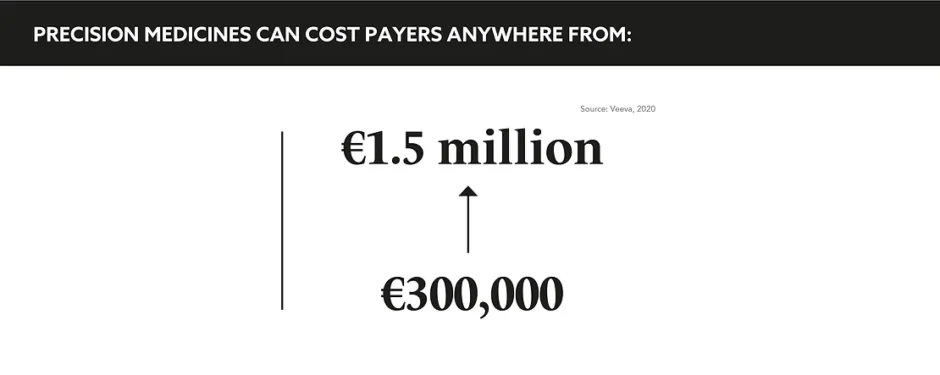Precision medicine could transform the standard of care from a one-size-fits-all approach into more precise and targeted disease treatment, but there is ground still to be covered when it comes to engaging payers and physicians with this practice
Words by Isabel O’Brien
On 30th January 2015, then-President Barack Obama took to the stage in the East Room of the White House with Alana Simon, a young computer scientist from Harvard University, whose life had been saved from a rare paediatric form of liver cancer through precision medicine. “You can match a blood transfusion to a blood type — that was an important discovery,” said President Obama. “What if matching a cancer cure to our genetic code was just as easy, just as standard?” That day, the Precision Medicine Initiative was launched, aiming to advance treatments that account for the variability of genes, environment, and the lifestyle of each individual.
Despite the continued existence of this initiative as well as the lifesaving potential for patients like Alana Simon, instances of precision medicine implementation are still few and far between. The pharmaceutical industry, and in particular medical affairs, has been facing complex challenges in convincing payers and healthcare agencies to rally behind precision medicine, an approach that defies the one-size-fits all methodology that is the current standard of care.
“Medical affairs teams face unique regulatory and reimbursement challenges linked to the rising cost of specialty precision medicine treatments. The maximum costs of new treatments have risen sharply in Europe, putting cost pressures on governments with pre-determined healthcare budgets,” says Marcelo Freire, VP, Head of Medical Affairs, Europe and Canada, Takeda.
Medical affairs teams face unique regulatory and reimbursement challenges linked to the rising cost of specialty precision medicine treatments
While these reservations are valid, with off-label use of targeted therapies compounding into reimbursement challenges for payers, MA must take on the role of a guardian angel, protecting and guiding this form of treatment into wider acceptance by justifying the outlay and demonstrating cost effectiveness. “MA organisations need to work with its cross-functional partners to generate real-world evidence to demonstrate the economic value behind its applications,” says Bora Erdemli, Europe Lead Medical Affairs Practice, ZS Associates.
Gathering financial evidence is a must, but we cannot expect payers to simply cough up the cash without conclusive proof that funding the cost of genotyping or molecular profiling will lead to improved outcomes in broad patient populations as well. “It is about agreeing with health technology agencies and payers on innovative research methodologies to show patient relevant outcomes,” says Joaquín Casariego, Head of Oncology Medical Affairs EMEA, Janssen. Outcomes knowledge must be gained through testing these medicines in clinical trials and real-world settings, with Casariego adding: “It can help to incorporate these research methodologies and patient relevant outcomes very early in the development of drugs – not very late, after, or when the drug is about to be marketed.”
While payers need to be convinced, another roadblock preventing adoption has been a lacklustre interest and velocity from physicians. “They [MA] need to establish a good level of understanding across HCPs on their perception and willingness to adopt molecularly guided treatment options,” explains Erdemli. If MA can uncover knowledge gaps and bridge this with evidence elucidating why molecular treatments are the future, they will be able to convert scepticism into advocation. “High-quality scientific content tailored to the specific needs from physicians is key to embedding evidence-based concepts around precision medicine into clinical practice,” says Freire.
The complexity of precision medicine must not be underestimated; while similar in principle to matching a blood transfusion to a blood type, screening for and delivering personalised treatments will demand that healthcare providers understand of vast swathes of big data. “As the complexity increases with the availability of more treatment options, medical education itself will not be enough, the information needs to be supported by decision-making tools to help physician contextualise the data and make better decisions for the care of their patients,” says Erdemli. Ensuring that physicians are supported as they become data miners in their own right, will also be crucial for bringing personalised medicine out of its infancy.
When President Obama concluded his speech, he described precision medicine as a “gift” that would enable us to “remake the world for future generations.” While such transformative progress is yet to be made, 6 years on, it is at least encouraging to see that the industry is aligned on why this development is so important.
As Casariego concludes: “You remember William Osler’s quote: `Medicine is a science of uncertainty and an art of probability’? This is absolutely true,” he says. “Precision medicine will help to reduce the uncertainty and increase the probability of taking the right decisions on individual patients and offer them something more inspirational that will impact their lives, which is the gift of time.” Precision medicine is not just a more detailed way of delivering care, it could enable us all to live longer and healthier lives, with MA set to be the liberators from the binds of one-size-fits all care.










